September 27, 2005
Cactus
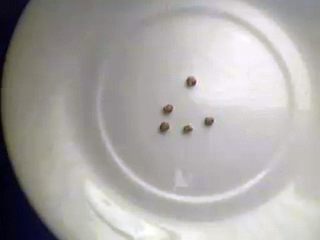 My newest horticultural experiment is with cactus seeds. This past weekend I was in Colorado for a friend's wedding. I had arrived early for the rehearsal so I was standing around the parking lot when I noticed a bright red fruit that had recently fallen off a small cactus plant.
My newest horticultural experiment is with cactus seeds. This past weekend I was in Colorado for a friend's wedding. I had arrived early for the rehearsal so I was standing around the parking lot when I noticed a bright red fruit that had recently fallen off a small cactus plant.
I found an empty Pringles can in the car (bad junk-food admission here!) so I popped the object into the can and later packed it into my bags and brought it back home to Los Angeles. Actually, I was a bit worried that I might be breaking some unknown law by transporting a plant on the airplane. I imagined that someone in security would think it was a peyote button or some such thing and detain me. Alas I made it through fine and brought the fruit (for a cactus, is the fruit called a "pear"?) home.
For the next two days I was too busy to look at my treasure, so it just sat inside a plastic bag, wrapped in a tissue. This morning when I retrieved it I discovered that the fruit had ripened dramatically. There was a powerfully sweet smell similar to strawberries. The fruit was very soft and when I squeezed it a mass that resembled preserves oozed out the end. This mass had many seeds that were coated in a slimy substance. It reminded me a lot of the inside of an extremely ripe pomegranate, actually.
I washed the mass of seeds and dried them on a paper towel, attempting to remove as much of the slimy coating as possible. In the end I had 90 mature-looking seeds and 10 lesser-developed seeds.
Now comes the question of how I'm going to try to germinate these seeds. Seed germination is a really tricky endeavor because seeds are designed to stay dormant for a certain amount of time and then become active under very specific stimuli. Some seeds stay dormant until they have been subjected to cold conditions for an extended period of time (a few weeks) to insure they sprout in the Spring. Other seeds are inhibited by some chemicals present in the fruit so they will germinate when they've been removed from the fruit (by some animal usually). Some seeds have very strong outer casings that must first be "damaged" whether by physical wear or by the digestive system of a bird or rodent before water can get through to start germination...
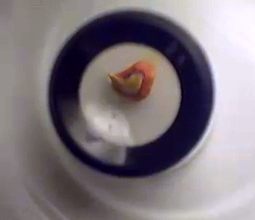 So I've got 90 seeds and need to come up with some means for experimenting quickly but effectively to find the best germination mechanism for this species. My gut feeling is that the growth-inhibiting mechanism was the slimy coating inside the seed case. Hence I'm hoping that one I've cleaned this coating off that the seeds with germinate readily. I also have a hunch this is the case because if you look at one of the seeds closely (see the photograph of a seed under a photographer's loop) you'll notice that the inner part of the seed appears to have a little tail that extends to the outside of the seed case. This doesn't look like a sort of super-armor casing that is going to require chemical or physical damage to get moisture to the embryo. But then again, I could be wrong.
So I've got 90 seeds and need to come up with some means for experimenting quickly but effectively to find the best germination mechanism for this species. My gut feeling is that the growth-inhibiting mechanism was the slimy coating inside the seed case. Hence I'm hoping that one I've cleaned this coating off that the seeds with germinate readily. I also have a hunch this is the case because if you look at one of the seeds closely (see the photograph of a seed under a photographer's loop) you'll notice that the inner part of the seed appears to have a little tail that extends to the outside of the seed case. This doesn't look like a sort of super-armor casing that is going to require chemical or physical damage to get moisture to the embryo. But then again, I could be wrong.
Another known variable is the length of viability (aka shelf life) of these seeds. I've read that there is a huge amount of variety in seed storage length, from a couple of weeks to 20-30 years under the best cryogenic conditions! If I create an experiment to determine the optimum germination strategy and don't factor in shelf-life, I could end up with greatly skewed results. Also there's the question of what proportion of the seeds are viable. Maybe only 1 in 4 seeds is capable of germinating, in which case if I try varying conditions in batches of 2-3 seeds I may have entire batches that don't germinate despite being in the best possible growing condition!
Here are my thoughts: I think I should store most of these seeds in the refrigerator. Since the plant was found in the foothills of Colorado, it obviously can survive winter conditions. I'm guessing that the refrigerator will not harm the seeds, and if anything it should probably extend their shelf-life and might trigger a temperature mechanism that might be required for germination!
Since I have 90 seeds, I think my "batch size" for trying different germination techniques will be 6 at a time. That will allow for 15 different germination conditions which I'll have to plan out soon.
My germination strategy will be this: I have a squat cylindrical plastic case that looks something like a huge petri dish. I will place a seed on a small piece of rock-wool (so it's not sitting in water which could induce rot) and I will apply some moisture to the container with a spray bottle. Then I'll cover the container with plastic wrap. This way I can tell instantly if the seed is germinating. If or when it does, I will plant the sprout when it is about a centimeter in length.
Here goes nothing!
New Writings on Horticulture
I've created a new "category" for my homepage blog called Horticulture to be dedicated to talking about growing things—a hobby that I've found a true love for.
I also never would have guessed how much "science" there is in horticulture. Raising and keeping plants involves much more than occasionally watering your plants. There are all sorts of interesting topics that involve an understanding of specific scientific topics. Here's an example:
- Fertilizer In addition to getting the right balance of the three primary nutrients (Potassium, Nitrogen, Phosphorus) to encourage general growth or blooming (or runner development in strawberries), there's the understanding of how bacteria work to help the roots function. Did you know that bio-decomposition creates acid (low pH) as a side-effect, which is necessary for proper nutrient uptake in roots? In hydroponics your growing medium is sterile so you have to provide an acid source yourself.
- Pruning, flowering and hormones Flowers and the tips of stems produce growth inhibiting hormones that keep nodes dormant along the length of the stem. Prune the tip of a stem and these nodes start growing branching stems. This is really useful to understand when your impatiens begin to look gangly! It also dictates strategies for pruning shrubs if you don't want them to get too thick and knotted.
- Seed Germination Starting new plants from seeds is not an easy endeavor. Different seeds have different storage lives and require different storage conditions. Also, different plants' seeds have different strategies for deciding when it's acceptable to germinate. Simply popping a seed from a fruit into the soil and watering rarely results in a plant.
The cool thing about growing plants is it can be inexpensive, and when your experiments fail, well... it's not all that devastating. (Okay, I felt a little sad when I threw out my problematic avocado plants. Yes, they're dead now.) I've turned into a bit of a nut recently. I will pinch off a small stem from some nice looking shrub while walking down the street, take it home and try to root it. Last weekend at my friend's wedding rehearsal I noticed a cactus plant with a ripe fruit that had just fallen off the plant. I placed the fruit inside a used Pringles can and took it home.
I've tried rooting two Pineapple tops. The first one didn't make it (started decomposing without a single root developing) but the second one is looking more promising.
The number of experiments I've got running is pretty extensive, and I'm in the mood to write about them, so there may be a lot of horticulture writing on this blog in the near future!
July 20, 2005
Love of Horticulture Part 2
One of my early blogs (mid-June last year) I wrote at some length about my little porch and houseplant projects. At that time I was gearing up for a trip to London (as I am again today) and I posted pictures of my little babies.
 Among other things was "the plant that would not die" that was a carry-over from the previous owner. After I pretty much tried to kill the plant with neglect, I decided it deserved to live and have been watering it. The thing is several feet taller (can now look over the balcony with standing on anything!) and doing rather well. There are some other similar-looking plants (but certainly different species) that are growing as well. I have no idea how they got in that pot, but I just keep giving it water and it keeps growing!
Among other things was "the plant that would not die" that was a carry-over from the previous owner. After I pretty much tried to kill the plant with neglect, I decided it deserved to live and have been watering it. The thing is several feet taller (can now look over the balcony with standing on anything!) and doing rather well. There are some other similar-looking plants (but certainly different species) that are growing as well. I have no idea how they got in that pot, but I just keep giving it water and it keeps growing!
One of my ferns is turning out to be seriously gorgeous! I put it in one of those "self-watering pots" that has a water reservoir in the bottom—it uses wicks to pull the moisture up into the soil—and it is doing incredibly well. (The second fern needs to find a hook. I think the act of gently twisting around in the wind has allowed my "prize" fern to become perfectly symmetrical. Anyway, they are doing well.
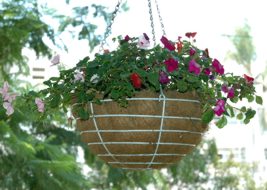 The Impatiens have been interesting. These are colorful flowers that are supposed to be annuals, but in a climate like Los Angeles that never frosts, they can keep growing. The problem is that the stems get long and funky and they start looking like big mutant octopi! But I found that seriously pruning them back, the foliage comes back perfectly healthy. A hanging basket of Impatiens is, I think, one of the nicest things you can have on a balcony.
The Impatiens have been interesting. These are colorful flowers that are supposed to be annuals, but in a climate like Los Angeles that never frosts, they can keep growing. The problem is that the stems get long and funky and they start looking like big mutant octopi! But I found that seriously pruning them back, the foliage comes back perfectly healthy. A hanging basket of Impatiens is, I think, one of the nicest things you can have on a balcony.
Finally, I've got the great experiment: Hydroponic Strawberries. Since I was a kid I was fascinated by the field of hydroponics (growing plants without dirt) and at times I've tinkered around with it. One of the advantages to hydroponics is that once you get everything established, it can be relatively low-maintenance. Some hydroponic kits can store water in a reservoir and gradually feed plants over a week or longer!
As I wrote in my earlier blog, my apartment gets almost no direct sunlight. It's in fact a rather dark place. Some may like the subterranean feel; I do not. I've been brewing in the back of my mind the concept of marrying indoor hydroponic houseplants and indoor lighting that would both supplement the plants' light needs and brighten up the apartment. Ultimately, I think it would be cool to design large sculpture-like pieces of furniture that held some plants, fed them automatically (so one could go on business trips for over a week without needing a plant-sitter) and had built-in lighting that would feature them and brighten the overall room.
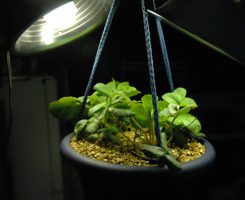 Okay, I suspect such a project would be incredibly geeky, but why not? I don't know why, but I also become interested a few months back in strawberries. They're an interesting plant because they can multiply easily if you just plant the runners. I've also heard they respond well to hydroponics, and it just seemed that if I were to experiment with some thriving indoor plant, why not one that would yield a constant crop of strawberries year-round?
Okay, I suspect such a project would be incredibly geeky, but why not? I don't know why, but I also become interested a few months back in strawberries. They're an interesting plant because they can multiply easily if you just plant the runners. I've also heard they respond well to hydroponics, and it just seemed that if I were to experiment with some thriving indoor plant, why not one that would yield a constant crop of strawberries year-round?
So I bought a Strawberry plant that was already planted in a hanging basket. I then clamped two cheap $5 shop lamps to the top of the basket, fitted them with those funky new high-efficiency fluorescent bulb fixtures (excellent because they give off a lot of light for much fewer watts than standard bulbs and don't put off hardly any heat!) and plugged them into a timer that would give the plant 16+ hours of good strong light per day.
Note that none of this (yet) has to do with hydroponics. My intention was to root the 2 runners and start them out baby hydroponic strawberries!
I'll write a little bit tomorrow about that project. This blog is already getting a bit long.
June 10, 2004
Growing Things
 Anyone who's known me for long enough knows I love to grow plants. When I was a child I was fascinated with hydroponics and always wanted my own advanced hydroponic greenhouse. (And some day I'll have a house with a yard where I can build one.)
Anyone who's known me for long enough knows I love to grow plants. When I was a child I was fascinated with hydroponics and always wanted my own advanced hydroponic greenhouse. (And some day I'll have a house with a yard where I can build one.)
Ten years ago I moved into one of my mom's rental units (a duplex) and put together both a hydroponic kit and dug a nice 20' x 20' garden plot in the back yard. I grew the plants from seeds, starting in February indoors with one of those plastic tubs with the little indentations for each seedling. It's an amazing feeling to start with just some little sprouts and end up at the summer with a huge thriving forest!
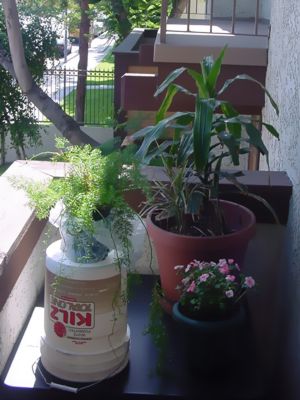 When I moved to New York my apartment (co-op) had just two North facing windows. Before long I was borrowing single-leaf clippings from friends' African Violets and planting them. I think I ended up with at least half a dozen plants dotting the windowsill, sucking in what little light got pulled into the apartment.
When I moved to New York my apartment (co-op) had just two North facing windows. Before long I was borrowing single-leaf clippings from friends' African Violets and planting them. I think I ended up with at least half a dozen plants dotting the windowsill, sucking in what little light got pulled into the apartment.
So now I've been in my Los Angeles apartment (condo) for 18 months and I can't take it anymore! I've been bitten by the planting bug! It is actually a collection of little stories. (And if this bores you, sorry. I just love my little plants so I'm going to keep rambling.)
First there was the plant that would not die. When I bought this place there had been a couple plants—mostly dead—left on the balcony. There was a dead tree, a huge pot with some evidence of another long-dead corpse, and a ratty looking plant on its last legs. I've got no idea what species it is.
The balcony has been a place where I usually avoided. The accumulation of soot (I'm on a busy street) and grime didn't make it too pleasant to visit. My roommate Hans would go out there to smoke, but that's about it. This Spring I actually took notice of the plant-that-would-not-die. It had been well over a year and apart from the RARE rainfall, the plant had never been watered. I even asked Hans if he ever put some water on it and he said no.
So I figured if that thing could last so long with complete neglect, it might thrive if I gave it some care. You can see it in the picture with the three plants sitting on a table. It's the tall feller.
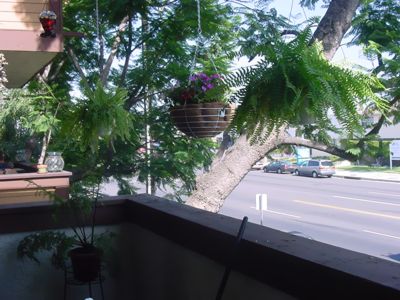 Story #2 is about the Boston Ferns. Actually it's a brief tale. I wanted some plants for indoors and bought to ferns at the grocery store. I tried hanging them in my bedroom and in the kitchen, but this apartment gets almost light so they looked like they were on their way to ruin. After I returned from Colorado where I'd been finishing my master's degree I made a mission of bringing them to life.
Story #2 is about the Boston Ferns. Actually it's a brief tale. I wanted some plants for indoors and bought to ferns at the grocery store. I tried hanging them in my bedroom and in the kitchen, but this apartment gets almost light so they looked like they were on their way to ruin. After I returned from Colorado where I'd been finishing my master's degree I made a mission of bringing them to life.
There's a single place (on my keyboard, actually) in my room that ever got any sunlight, so I would position both ferns there. I would occasionally spray their leaves with water to keep them moist. They have responded wonderfully, but now that the Summer Sun is higher in the sky my bedroom no longer gets any sun. So I moved the ferns out to the balcony.
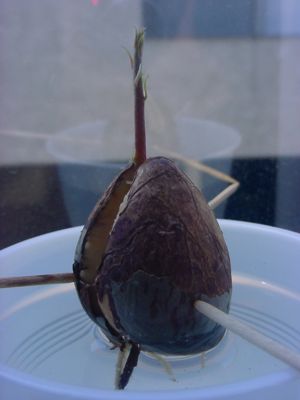 Story #3 is about avocados. I've just started falling in love with this Fruit of God and every time I visit the local Farmers' Market I always buy three or four to each over the week whenever I think they've ripened. I remembered hearing about people growing avocado pits so I looked on the web to find instructions. I got out a plastic cup and three toothpicks and set up four pits a few weeks ago.
Story #3 is about avocados. I've just started falling in love with this Fruit of God and every time I visit the local Farmers' Market I always buy three or four to each over the week whenever I think they've ripened. I remembered hearing about people growing avocado pits so I looked on the web to find instructions. I got out a plastic cup and three toothpicks and set up four pits a few weeks ago.
Some of them have split and two or three have sent out a root. One has been far ahead of his peers. I've named him Seymore because he reminds me of the Little Shop of Horrors. (I know, in the musical the plant's name was Audrey. I like Seymore better, though.)
A few weeks down the line and I have almost a dozen avocado pits set up in my bathroom. I'm hoping two or three more will start growing.
So now the planting bug has really hit me. I went to the nursery and bought two more ferns and a bunch of Impatiens which I set in one of those neat hanging baskets. I also got a Hummingbird feeder! I've decided that I'm going to really clean up that balcony and do the Extreme Makeover and turn it into something beautiful.